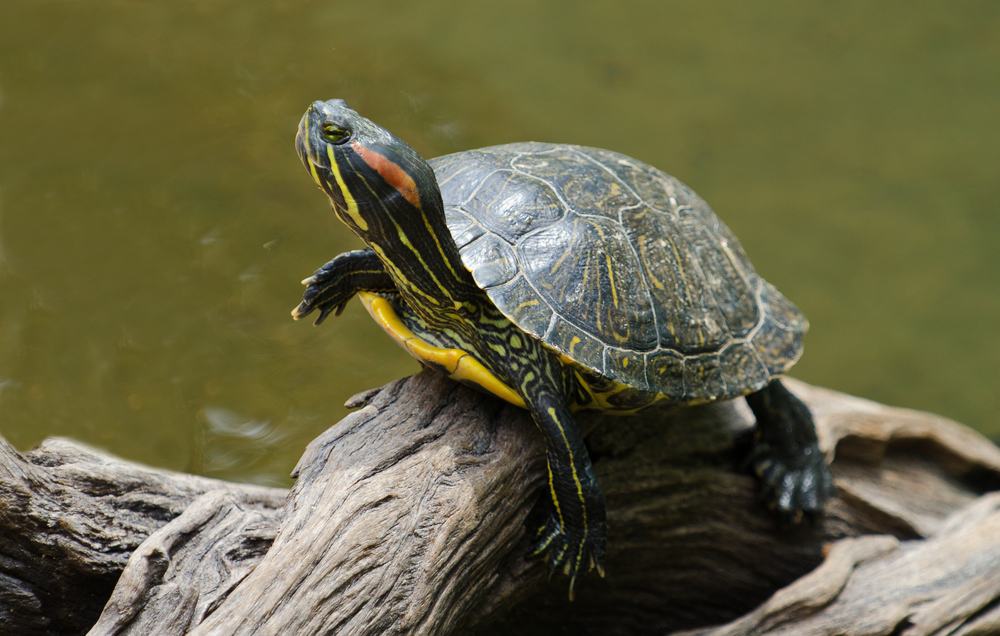The Red Eared Slider has been a favorite household pet for many years!
Because they can can tolerate a wide variety of conditions and become quite tame in captivity, Red Eared Sliders make wonderful pets. They are quiet, and when tame are calm and generally slow-moving. Consequently they don’t instill the cautious concerns that some folks have when dealing with other types of reptiles. They can be quite hardy when provided with the right environment, have fairly modest requirements, and live a long time.
These are some of the most prolific and widespread species of freshwater turtles in the world. In addition there are several beautiful color morphs of the Red-eared Slider available; including albino, pastel, and leucistic.
- For more information see: Selecting and Caring for Your Turtle or Tortoise
Scientific Classification
| Kingdom: | Animalia |
| Phylum: | Chordata |
| Class: | Reptilia |
| Order: | Testudines |
| Family: | Emydidae |
| Genus: | Trachemys |
| Species: | scripta |
Distribution
Red-eared Sliders are found in the United States from Virginia to Florida and west to Kansas, Oklahoma, Texas, and New Mexico. They have also been introduced into habitats throughout the world. Fourteen other Trachemys species and subspecies are found throughout Central and South America.
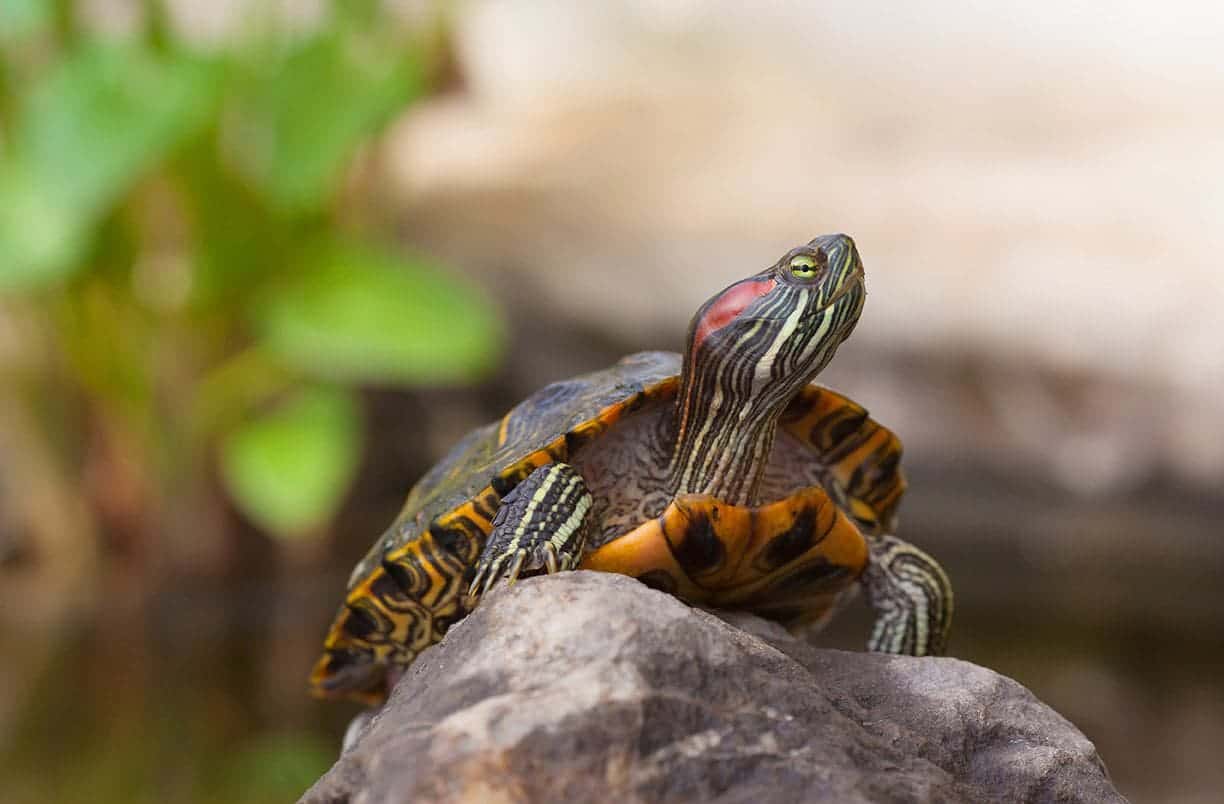
Status
The Common Sliders Trachemys scripta are listed on the IUCN Red List of Threatened Species: LR – lower risk.
Description
Over their incredibly large range in nature, Red-eared Sliders are quite variable in patterning and color. They can be grayish green, bright lime green with wonderful yellow spots and squiggles, or dark green with dark markings. They all have the typical red “ear” coloration that runs from the eyes to the back of the head. This coloration can have a variety of shapes and a range of color, but all true Red-ears have this characteristic.
Males of all populations of Red-ears become darker as they age. Some become an entirely black turtle with the pattern and even the red “ear” difficult to see. Males are usually smaller than females and with larger front claws and longer tails. This species generally ranges between 8 to 10″ (20.3 – 25.4 cm) with a maximum recorded size of 11.4″ or 28.9 cm (Conant and Collins, 1991).
Care and Feeding
Red Eared Sliders exhibit a feeding pattern typical of many freshwater turtle species. As young, they are carnivores, eagerly consuming insects, insect larvae, and a variety of other invertebrates. As they grow, they begin feeding on a variety of plant matter in addition to the live prey. As they reach adulthood, most sliders will continue to feed on animal matter in the form of fish, worms, and insects.
In captivity, most sliders will eagerly eat commercial turtle food and will eat large amounts of the aquatic plants found in their enclosures. Respect their need for a varied diet as young sliders are prone to shell defects and abnormal growth due to insufficient diets.
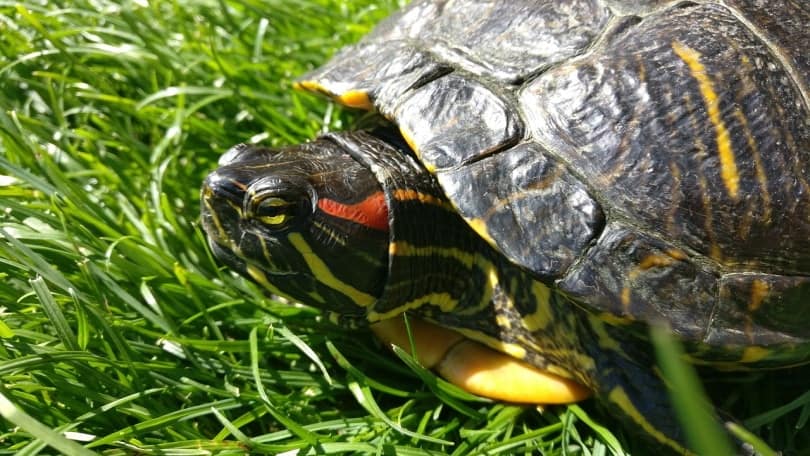
Environment
Indoors
A basic setup in a large tub (48″w x 84″l x 20″d) or stock tank will be sufficient to hold three or four adult Red-eared Sliders. Add an efficient filtration system, a shop light fixture with UVB-emitting bulbs, and at least one basking spot with a 100-watt spotlight mounted above.
Add a variety of floating and submerged aquatic plants to the slider enclosure. In addition to helping keep the water clean and healthy, plants will add some variety to the sliders’ diet.
A good beginning home for a small or baby Red Eared Slider is an aquarium. Purchase at least a 20-gallon aquarium. Also required are a filter, a heater, a pump and airstone, a sandy or gravel substrate, live aquatic plants, chlorine remover and other water conditioners, and a small bulb to provide a basking spot for the young turtle.
None of these supplies can be left out of the proper baby turtle enclosure. Fortunately, these turtles are typically very hardy captives and thrive in proper conditions.
Outdoors
The Red Eared Slider does very well in outdoor ponds. It can thrive outside in warmer climates and is active year-round. It will hibernate in more severe environments and can tolerate cold winter conditions, often hibernating under the ice.
They love to bask, so at least one large basking spot per enclosure should be available. Outdoors, ponds and pools must be secure as Red-eared Sliders will usually leave unfenced areas quickly – The “Call of the Wild” pulling them to the local farm pond or nearby river.
Care must be taken that these, and any turtles, are not released into a wild habitat. The reasons are many. The introduction of non-native species can lead to the introduction of diseases and can lead to hybridization of introduced and native species. In addition, many turtles raised in captivity and released into wild situations are confused, unable to cope with extreme weather changes, and many surely fall prey quite quickly to the wary predators they may encounter.
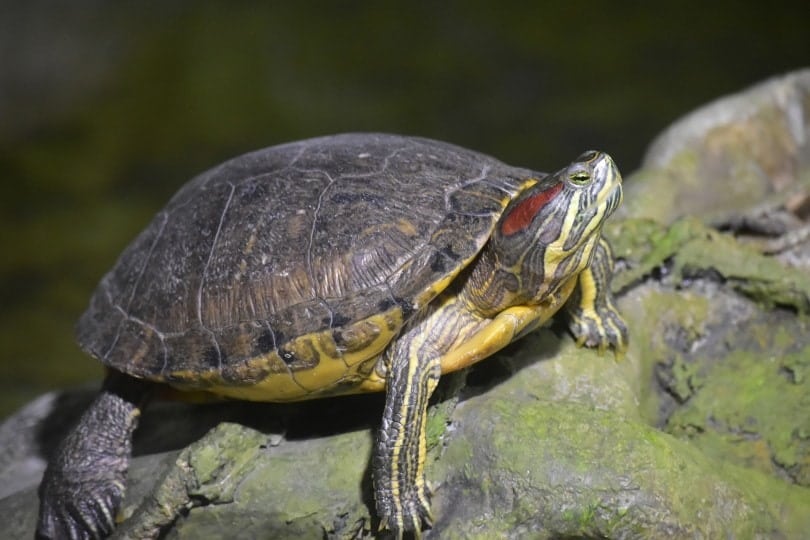
Handling
Red Eared Sliders become very tame in captivity and will tolerate some handling. They will readily swim up to the keeper and take food out of his or her hand. They become quite curious and will watch anyone in the room with them in hopes of getting a free handout.
Older sliders and those kept in ponds tend to be more nervous and will scratch and flail when removed for handling or cleaning.
Breeding
Adult males of many species of sliders are characterized by the growth of long claws on their front feet. In addition many male sliders grow darker as they age. This appearance of long claws and the trend toward melanism can aid the slider keeper in identifying his males and females at a glance.
Captive breeding is simple and straightforward in most sliders. The male engages in an elaborate courtship ritual that involves swimming above the female, scratching her carapace with his elongated nails, head twitching, and more. If their environment is healthy and females are given access to a proper laying area, sliders are quite prolific producers. Adults breed throughout the spring and a female can lay up to three clutches of 6-10 eggs each year. This species exhibits temperature dependent sex determination; eggs incubated at less than 80° F (27° C) produce males, 82 to 84° F (28° to 30° C) produce a mixed ratio, and those incubated at 86° F (30° C) produce females.
Be aware that adults eagerly consume hatchlings if a nest hatches within the adult’s enclosure. Care must be taken to remove the eggs for incubation or to protect the nest with a wire cage if it is to be incubated on-site.
Hatchlings thrive in the proper environment with good water quality, UVB and heat, and a varied diet. Babies relish invertebrates such as blackworms, small redworms, and even crickets as well as commercial pelleted food. They grow quickly and can reach breeding size in 3-4 years.
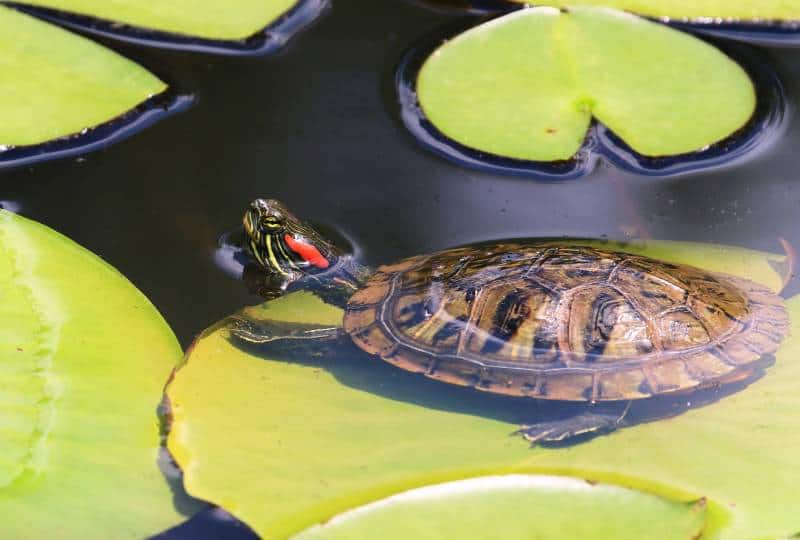
Ailments / Health Problems
Not many, but shell and skin infections arise from poor nutrition and ear abscesses are occasionally seen in sliders kept in poor quality water with abnormally high levels of bacteria. These injuries can be treated by removing the turtle from the water. The infected area should be dried and an application of Betadine followed by a layer of silvadene cream should be applied. The turtle should be kept warm on a towel in a tub for several hours before it is returned to the water. This should be repeated every day for a week while the area heals.
If the turtle’s water is not clean and aerated the problem will recur quickly. If the turtle is being bullied or too many turtles are kept in a small enclosure, this and other problems will occur until the situation is corrected.
Availability:
Red-eared Sliders are commonly available throughout the U.S. in pet stores, at reptile shows, and on-line. They are usually inexpensive to purchase but one must realize that the expenses of setting up a proper environment are considerable.
Featured Image Credit: Simon_g, Shutterstock
